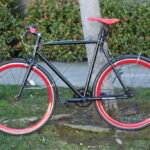If you’re a cyclist, navigating the various options for a reliable bike computer can be distressing. In this comprehensive Garmin bike computer comparison, we will explore the saturated market to help you find the ideal device.
It is not easy to find one that tracks speed, distance, heart rate, and more, while also offering navigation and connectivity. Our focus is on delving into the intricacies of leading Garmin bike computer models.
By evaluating their features, benefits, and prices, our goal is to guide you to the perfect Garmin companion for your cycling needs. Let’s discover the optimal device for you!
What Can a Garmin GPS Computer Do?
A Garmin GPS computer is a multifaceted device designed to elevate your cycling experience. With common key features across Garmin bike computers, these devices offer precise navigation, real-time performance tracking, and enhanced safety features.
Whether you’re a recreational cyclist or a seasoned pro, expect advanced GPS functionality, accurate distance tracking, and insightful metrics for optimizing training. The intuitive interface provides accessibility, while Bluetooth connectivity ensures seamless data sharing.
Garmin GPS computers also incorporate features like suggested workouts, personalized coaching, and climb analysis. From planning routes to monitoring your stamina, a Garmin GPS computer is a comprehensive tool, that ensures a connected and informed cycling journey.
Garmin Bike Computer Comparison
| Edge Explore 2 | Best For Casual Exploration |
| Garmin Edge 1040 | Best Performance |
| Edge 1040 Solar | Best Battery Life |
| Garmin Edge 840 | Best Versatile Computer |
| Edge 840 Solar | Best For Eco-Conscious Riders |
| Garmin Edge 540 | Best For Intermediate Functionality |
Best Garmin Bike Computer Comparison
1. Edge Explore 2
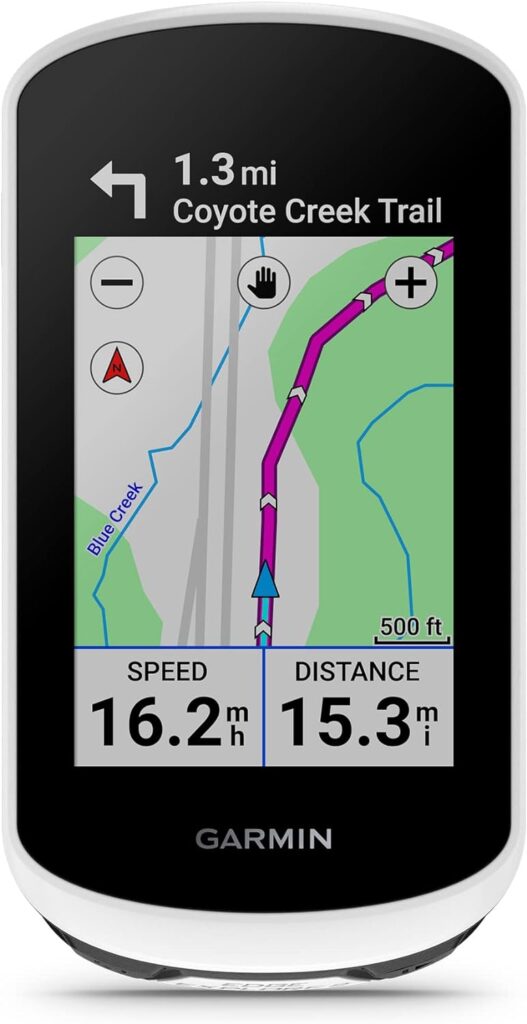
Screen Size: 3 Inches | Weight: 4.1 Ounces | Battery Life: 16 Hours
Pros
- Affordable
- User Friendly
- On Device Music
Cons
- Low Responsiveness In Very Cold Weather
The Edge Explore 2 is a game-changer for cyclists seeking a user-friendly GPS companion. Boasting a 3-inch high-resolution touchscreen, this GPS cycling computer ensures visibility even in direct sunlight, making it glove- and rain-friendly.
The simple setup, along with preloaded road, off-road, and indoor activity profiles, offers a hassle-free experience right out of the box. Ideal for diverse bike types, it features improved ride type-specific maps highlighting popular roads, trails, and even eBike routing for confident exploration.
Stay aware of high-traffic roads with real-time map displays and receive navigation guidance when connected to your compatible eBike. Paired with your smartphone, enjoy LiveTrack, GroupTrack, smart notifications, and incident detection during outdoor rides.
The built-in GPS tracks essential metrics, while compatibility with sensors allows monitoring heart rate, bike speed, and cadence. With seamless integration with Varia cycling awareness devices, this Edge Explore 2 is a versatile and connected companion, enhancing your cycling experience on various terrains.
2. Garmin Edge 1040
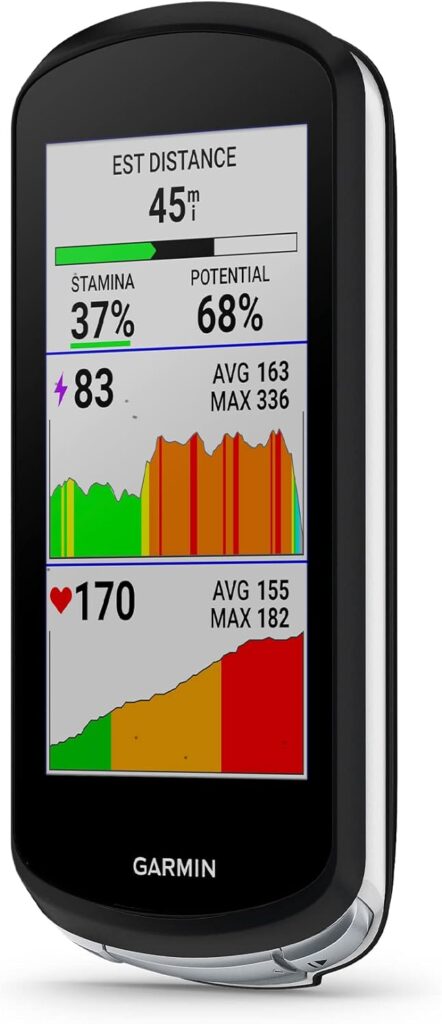
Screen Size: 3.5 Inches | Weight: 4.4 Ounces | Battery Life: 35 Hours
Pros
- Easy Setup
- Slim Design
- Swift GPS Reception
Cons
- Excessive Beeping
This is a high-performance GPS bike computer that seamlessly combines advanced navigation, planning, and performance tracking features. In a sleek black design, it offers a user-friendly experience.
The 3.5-inch screen, powered by multi-band GNSS technology, ensures precise navigation even in challenging environments. Its streamlined interface simplifies setup and provides easy access to essential information.
The device excels at categorizing cyclist strengths, comparing abilities to course demands, and offering power guide recommendations for optimized training. With insights into stamina and prompts for missed workouts, it keeps cyclists on track with their training programs.
Connectivity with popular apps like Strava and Komoot enhances the overall experience. Moreover, it has up to 35 hours of battery life in demanding use cases (and up to 70 hours in battery saver mode), making it a reliable companion for cyclists seeking top-tier features and performance.
3. Edge 1040 Solar
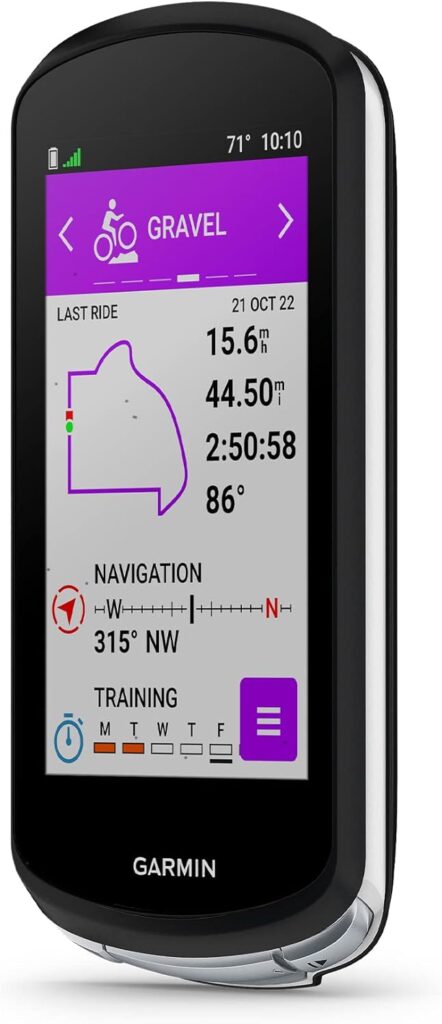
Screen Size: 3.5 Inches | Weight: 4.7 Ounces | Battery Life: 100 Hours
Pros
- High GPS Accuracy
- Extended Battery Life
- Effortless Device Pairing
Cons
- Expensive
This redefines cycling technology with its innovative features and sustainability. Boasting a 3.5-inch screen and Bluetooth connectivity, it excels in navigation, performance tracking, and smart connectivity.
The Power Glass solar charging lens extends battery life up to 100 hours in battery saver mode or 45 hours in demanding use cases. During daytime rides, it adds up to 42 minutes per hour in battery saver mode and 20 minutes per hour in demanding use cases, ensuring a reliable and eco-friendly cycling experience.
With multi-band GNSS technology, the device provides enhanced positioning accuracy for navigating challenging environments. The streamlined interface allows easy access to information and course adjustments, making it user-friendly.
Classifying cyclist strengths, recommending power targets, and offering stamina insights, the Edge 1040 Solar is a comprehensive tool for cyclists looking to enhance their training and conquer diverse terrains while staying connected to their favorite apps.
4. Garmin Edge 840
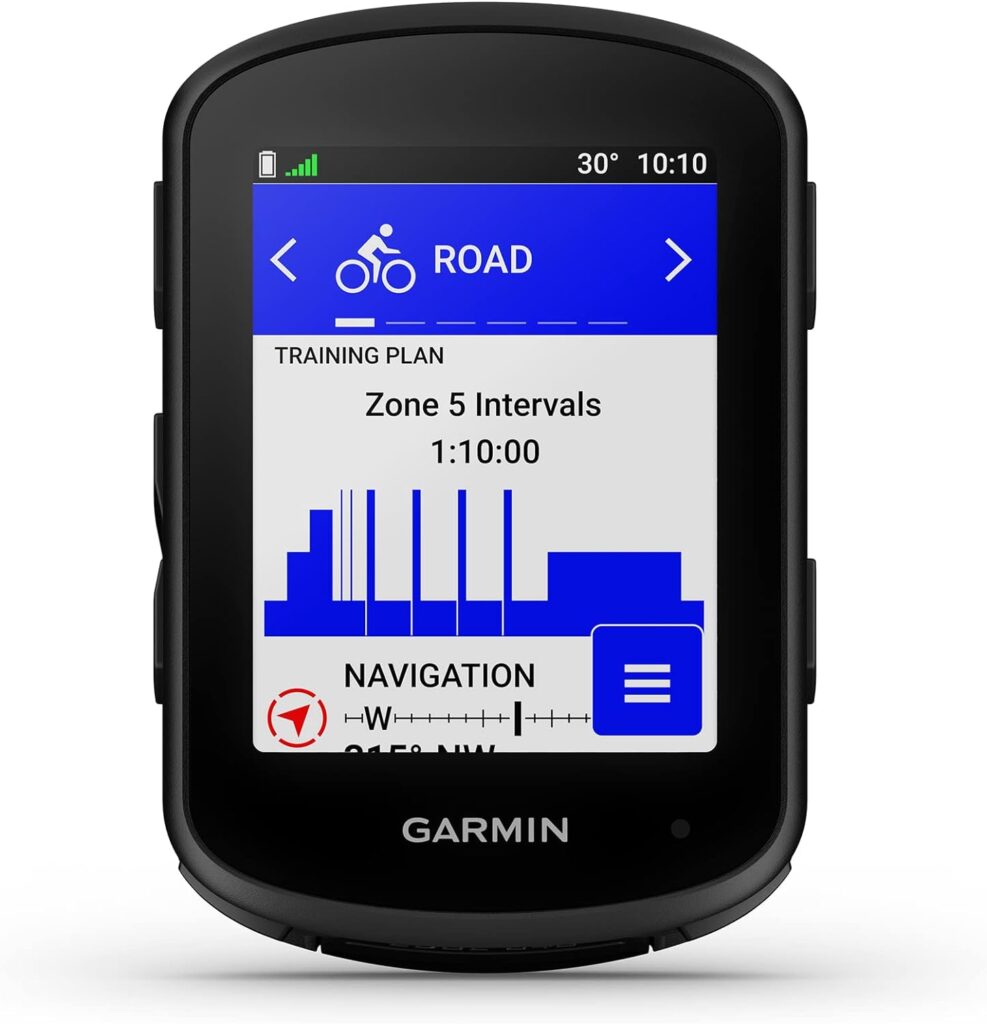
Screen Size: 2.6 Inches | Weight: 2.8 Ounces | Battery Life: 26 Hours
Pros
- Easy To Use
- Easy Sensor Migration
- Syncs Seamlessly With Components
Cons
- Requires Full Brightness During Day Time
The Garmin Edge 840 stands out as a top-tier GPS cycling computer, seamlessly blending touchscreen and button control for superior navigation, planning, and performance tracking. With a battery life of up to 26 hours in demanding use cases and 32 hours in battery saver mode, it’s a reliable companion for long rides.
The device offers daily suggested workouts, personalized coaching based on your event, and adaptive training prompts when paired with a compatible power meter and heart rate monitor. Multi-band GNSS technology ensures precise navigation in challenging environments, while the ClimbPro ascent planner displays the remaining ascent and grade during climbs.
The Edge 840’s power guide feature recommends power targets and stamina insights help monitor endurance. With improved ride-specific maps, smart notifications, and comprehensive analytics, this Garmin enhances every cycling experience, making it an ideal choice for riders seeking advanced features and performance tracking.
5. Edge 840 Solar
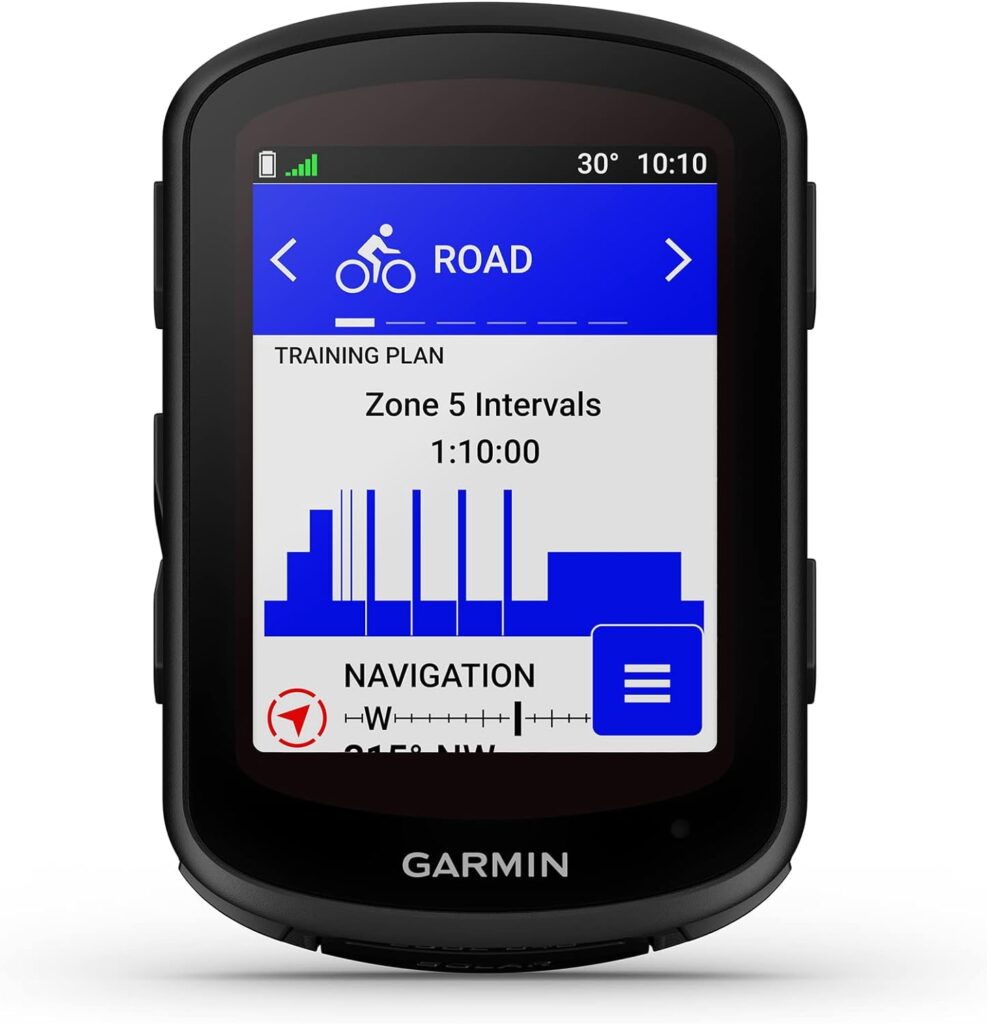
Screen Size: 2.6 Hours | Weight: 3 Ounces | Battery Life: 60 Hours
Pros
- More Battery Life
- Effectively Connects To Sensors
- Easy Data Screen Configuration
Cons
- Dim Solar Screen Contrast Requires High Brightness
This revolutionizes GPS cycling computers with its advanced features and innovative solar charging technology. This device seamlessly integrates touchscreen and button control for superior navigation, planning, and performance tracking, making it an ideal companion for cyclists.
With a battery life of up to 26 hours in demanding use cases and an impressive 60 hours with solar charging in direct sunlight, it ensures longevity on the road. When paired with compatible sensors, the Edge 840 Solar provides daily suggested workouts, personalized coaching based on your event, and stamina insights.
Multi-band GNSS technology guarantees accurate positioning, and the ClimbPro ascent planner adds a layer of functionality for climbing enthusiasts. With improved ride-type-specific maps, smart notifications, and comprehensive analytics, this Garmin is perfect for riders seeking top-notch features, sustainability, and enhanced connectivity in their cycling experience.
6. Garmin Edge 540

Screen Size: 2.6 Inches | Weight: 2.8 Ounces | Battery Life: 26 Hours
Pros
- Quick Satellite Locating
- Easy Screen Readability
- Improved Data Accuracy
Cons
- No Touch Screen
It stands out as an advanced GPS cycling computer, offering an exceptional blend of functionality and connectivity. Featuring button controls, this device combines superior navigation, planning, and performance tracking for cyclists seeking a well-informed and effortless ride.
With a battery life of up to 26 hours in demanding use cases and an impressive 42 hours in battery saver mode, it ensures longevity on the road. When paired with compatible sensors, the Edge 540 provides daily suggested workouts, personalized coaching based on your event, and stamina insights.
Multi-band GNSS technology guarantees accurate positioning, and the ClimbPro ascent planner adds a layer of functionality for climbing enthusiasts. With improved ride-type-specific maps, smart notifications, and comprehensive analytics, this Garmin is perfect for riders looking for a reliable and feature-rich cycling companion.
Are Bike Computers Worth It?
Bike computers are worth it to track your speed, distance, time, heart rate, cadence, power, and other metrics while cycling. They can help you improve your performance, monitor your progress, and plan your routes.

Bike computers can also enhance your safety and enjoyment by providing navigation, alerts, and entertainment features. Whether you are a casual rider, a commuter, a fitness enthusiast, or a competitive cyclist, there is a bike computer that suits your needs and budget.
How Much Should I Spend on a Cycling Computer?
The price of a cycling computer depends on the features, quality, and brand of the device. You can find basic models that cost less than $50 and can display basic information such as speed, distance, and time.
However, if you want more advanced features such as GPS, wireless connectivity, color display, touch screen, maps, and sensors, you may need to spend more than $100. The most expensive models can cost over $500 and offer high-end performance, accuracy, and durability.
Ultimately, the amount you should spend on a cycling computer depends on your personal preferences and goals.
How Easy Are Cycling Computers to Set up?
The ease of setting up a cycling computer varies depending on the model and the type of installation. Some models are easy to install and use, requiring only a few steps and minimal tools. Others may require more time and effort, especially if they involve wiring, sensors, or mounts.

Generally, wireless models are easier to set up than wired ones, as they eliminate the hassle of cables and connections. However, wireless models may also require pairing, syncing, or updating, which can be tricky for some users.
The best way to ensure a smooth and easy setup is to follow the instructions provided by the manufacturer or consult a professional if needed.
Do I Need a Touchscreen Cycling Computer?
A touchscreen cycling computer can offer convenience, functionality, and interactivity. It can allow you to access and control the features of the device with a simple touch or swipe, without having to press any buttons.
Additionally, it can also provide a clearer and brighter display, which can improve your visibility and readability. However, a touchscreen cycling computer may also have some drawbacks, such as higher prices, lower battery life, and reduced responsiveness in wet or cold conditions.
Therefore, whether you need a touchscreen cycling computer or not depends on your personal preference, budget, and riding environment.
How Much Battery Life Should I Look for?
The battery life of a cycling computer depends on the model, the features, and the usage. Generally, the more features and functions a cycling computer has, the more battery power it consumes. For example, GPS, wireless connectivity, backlight, and sensors can drain the battery faster than basic functions.

The usage also affects the battery life, as the more frequently and longer you use the device, the more battery it uses. Therefore, the amount of battery life you should look for depends on how often and how long you plan to use the cycling computer.
As a rule of thumb, you should look for a cycling computer that can last at least as long as your longest ride.
What Are the Alternatives to a Bike Computer?
If you don’t want to buy a bike computer, you can use your smartphone. Download apps and employ accessories like mounts and sensors to transform your phone into a cycling companion, measuring speed, distance, time, elevation, and more.
Despite its convenience, be mindful of potential limitations such as shorter battery life, smaller displays, and accuracy concerns.
Consider fitness trackers or smartwatches as additional alternatives, offering limited cycling metrics and smart features, albeit with potential drawbacks in comprehensiveness, reliability, and compatibility compared to dedicated bike computers.
Conclusion
You have just read a comprehensive guide about Garmin bike computer comparison, which offers various features and benefits for different types of cyclists.
Whether you are looking for a simple device to explore new routes, a powerful tool to monitor your performance or a smart gadget to connect with your phone and other sensors, there is a Garmin bike computer for you.
Which one would you choose and why? Let us know in the comments section below. We would love to hear from you and learn from your experience. Thank you for reading and happy cycling!
FAQs
Yes, for data transfer and sensor connectivity.
No, the mounts are brand-specific.
Both are reputable, but Garmin has more options.
Accuracy depends on the device and conditions; both are reliable.


